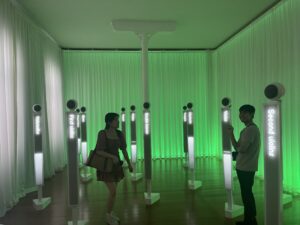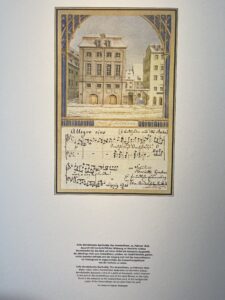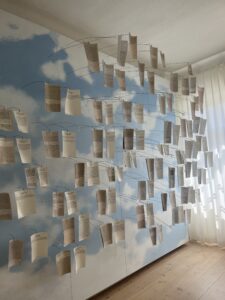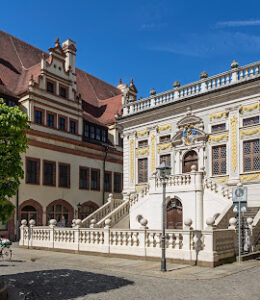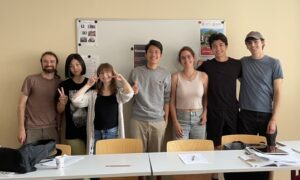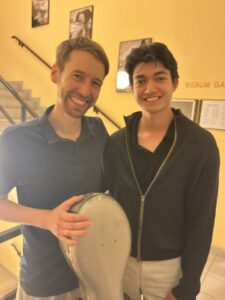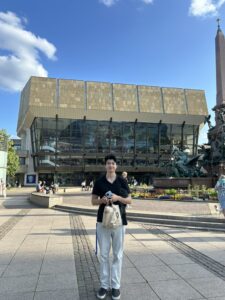I. Introduction
I have always loved music. I grew up listening to almost every genre you can imagine (excluding certain facets of country music, thanks to my parents’ strong preferences). I’ve been known to obsess over the soundtrack of an obscure film, or stop mid-conversation in a department store to Shazam a song that caught my ear. That passion has always been part of me. But does that make me a true listener?
Before coming to Leipzig, I realized my relationship to music had mostly been about enjoyment: what sounds good, what moves me. I rarely asked why it moved me, how it was structured to do so, or what about the space, the performers, or the history made a piece land a certain way. I arrived expecting to keep listening the way I always had—passively, intuitively. But over the course of this program, through the concerts, seminars, and just being here, something changed.
Leipzig’s musical spaces, architectural design, and historical weight pushed me to listen differently. From the sacred reverberations of the Thomaskirche to the clear acoustics of the Gewandhaus, each concert reshaped how I experience sound. Through this immersion, I came to realize: Leipzig didn’t just show me great music, but impactfully changed the way I listen to it.
II. Sound Meets Space: Architecture and Acoustics
When I first arrived in Leipzig, I believed I knew how to appreciate music. I expected the concerts to be enjoyable and maybe even inspiring. What I did not expect was that they would change how I listen altogether. That shift began with the Friday cantata concert at the Nikolaikirche. Sitting in the pews of this centuries-old church, I was struck not just by the music itself, but by the way the space carried and shaped the sound. The acoustics made each note feel both intimate and monumental. I could feel the vibrations of the performance surrounding me, not coming from a speaker or headphones, but from the architecture itself.
The next night’s performance at the Salle de Pologne brought a different type of transformation. The Coffee Cantata, full of humor and theatricality, showed me the importance of performance beyond sound. The soprano’s acting, much of which she told me afterward was improvised, gave the music an energy that I could see as well as hear. That experience helped me understand how much meaning in music can be communicated through gesture, body language, and tone. I began to listen with my eyes as much as with my ears.
By Sunday, during the St. John Passion at the Thomaskirche, I noticed something had shifted. I was no longer attending concerts as a passive observer. I was learning to listen with intention. I became more aware of the emotional pacing of each piece, the relationship between music and space, and the powerful silence that follows a moving performance.
Rather than simply hearing what was being played, I was beginning to engage more fully. Leipzig gave me the opportunity to discover that listening can be active, reflective, and deeply connected to a place.
III. Performer Energy and Audience Connection
One of the most meaningful moments of my time in Leipzig was stepping into the role of a performer during our final recital at the Alte Börse. Until that point, I had spent most of the trip absorbing music from the audience’s side. I had been listening and reflecting, growing more aware of the spaces and stories that surround a piece. But performing inside a historic building, alongside fellow Princeton students I had grown close to, added an entirely new layer to that understanding.
As a performer immersed in the experience and space, I became intensely aware of the acoustics in a way I never could have imagined as just a listener. Every note we sang bounced back in surprising ways, sometimes ringing longer than expected, other times vanishing more quickly than I thought they would. Rather than feeling like sound was something we created and sent out, it felt as if we were working with the room, shaping each phrase with care and instinct.
There was something powerful about performing with people I had experienced Leipzig alongside. We had walked the same cobbled streets, sat in the same pews during concerts, and now shared the responsibility of creating something together. That connection made the music feel more alive, more personal. It was not just about getting the notes right. It was about expression, attention, and trust.
This experience reminded me that listening and performing are not separate. Each informs the other. Performing helped me realize that the act of music-making is just as much about responding to space and to each other as it is about technical skill. At that moment, I was no longer only learning how to listen, I was living it.
IV. The Role of Space
If Leipzig changed the way I listen, then its spaces were some of my greatest teachers. The architecture of each venue shaped the sound in a way that made the experience feel not just musical, but spatial and emotional. I began to realize that where you hear something can influence how you hear it.
The Thomaskirche, for example, gave works like the St. John Passion and the B minor mass a sense of reverence that could never be replicated in a conventional concert hall. The sound seemed to linger, filling the arched ceilings and stained-glass with something that felt almost weightless. Sitting in that space, I wasn’t just hearing the music, I felt surrounded by it. In contrast, the Gewandhaus offered clarity and balance. When I heard Brahms’s Symphony No. 4 there, I was struck by how crisp and articulate each section of the orchestra sounded, especially the brass and lower strings.
It wasn’t until I performed in the Alte Börse that I fully understood the intimacy that space can create. The hall was small, warm, and richly detailed. Singing there, I felt close to both the audience and my fellow performers. There was no sense of distance. The room invited a sense of reflection, control, and connection.
Across all of these spaces, I learned to listen not just to the music itself, but to how it responded to its surroundings. I started to understand sound as something physical, that moves through material and air and reaches people differently depending on where they listen. That awareness has stayed with me. It makes every performance feel more alive.
V. Personal Reflection: A Changed Listener
Before coming to Leipzig, I thought of myself as someone who simply loved music, but love alone doesn’t always mean deep listening. I rarely stopped to think about why I was drawn to certain sounds, how music worked, or how the space around it might shape my experience.
This city changed that. Through concerts in sacred churches and historic halls, I learned to listen differently. I started paying attention to more than just the melody by listening to space, to resonance, to silence.
Leipzig showed me that being a listener is active. It’s about being present, being curious, and letting the music shape you in real time. Sharing that experience with other student performers reminded me how vulnerable and joyful music-making can be. I’ve learned that the spaces we sing and play in carry meaning, and that being aware of them enriches every note.
I came to Leipzig expecting to enjoy the music. I didn’t expect to be changed by it. But I leave with a fuller understanding of sound, of performance, and of what it means to truly listen: with attention, with emotion, and with a sense of place.
